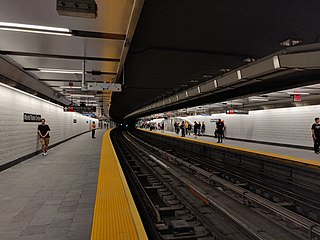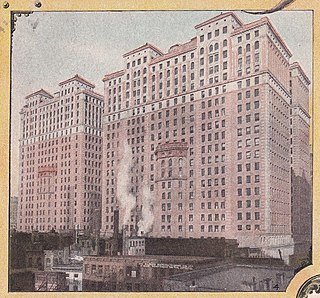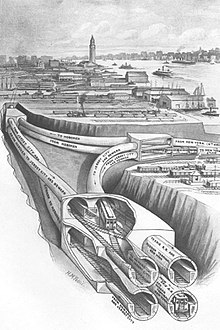
The Holland Tunnel is a vehicular tunnel under the Hudson River that connects Hudson Square and Lower Manhattan in New York City in the east to Jersey City, New Jersey in the west. The tunnel is operated by the Port Authority of New York and New Jersey and carries Interstate 78. The New Jersey side of the tunnel is the eastern terminus of NJ Route 139. The Holland Tunnel is one of three vehicular crossings between Manhattan and New Jersey; the two others are the Lincoln Tunnel and George Washington Bridge.

The Port Authority Trans-Hudson (PATH) is a 13.8-mile (22.2 km) rapid transit system in the northeastern New Jersey cities of Newark, Harrison, Jersey City, and Hoboken, as well as Lower and Midtown Manhattan in New York City. It is operated as a wholly owned subsidiary of the Port Authority of New York and New Jersey. PATH trains run around the clock year-round; four routes serving 13 stations operate during the daytime on weekdays, while two routes operate during weekends, late nights, and holidays. It crosses the Hudson River through cast iron tunnels that rest on the river bottom. It operates as a deep-level subway in Manhattan and the Jersey City/Hoboken riverfront; from Grove Street in Jersey City to Newark, trains run in open cuts, at grade level, and on elevated track. In 2023, the system saw 55,109,100 rides, or about 187,000 per weekday in the fourth quarter of 2023.

The New York Tunnel Extension is a combination of railroad tunnels and approaches from New Jersey and Long Island to Pennsylvania Station in Midtown Manhattan.

Manhattan Transfer was a passenger transfer station in Harrison, New Jersey, east of Newark, 8.8 miles (14.2 km) west of New York Penn Station on the Pennsylvania Railroad (PRR) main line, now Amtrak's Northeast Corridor. It operated from 1910 to 1937 and consisted of two 1,100 feet (340 m) car-floor-level platforms, one on each side of the PRR line. It was also served by the Hudson and Manhattan Railroad. There were no pedestrian entrances or exits to the station, as its sole purpose was for passengers to change trains.

The WTC Cortlandt station is a station on the IRT Broadway–Seventh Avenue Line of the New York City Subway in Lower Manhattan. The station is located under the intersection of Greenwich Street and Cortlandt Way within the World Trade Center. It is served by the 1 train at all times.

Exchange Place station is a station on the Port Authority Trans–Hudson (PATH) rail system in the Paulus Hook neighborhood of Jersey City, Hudson County, New Jersey. The station is on the Newark–World Trade Center line between Newark Penn Station and World Trade Center all week and the Hoboken–World Trade Center line during the day on weekdays to service Hoboken Terminal. Exchange Place provides access to the Jersey City waterfront and a station on the Hudson–Bergen Light Rail, where connections are available to Bayonne and North Bergen.

World Trade Center station is a terminal station on the PATH system, within the World Trade Center complex in the Financial District of Manhattan, New York City. It is served by the Newark–World Trade Center line at all times, as well as by the Hoboken–World Trade Center line on weekdays, and is the eastern terminus of both.

Ninth Street station is a station on the PATH system. Located at the intersection of 9th Street and Sixth Avenue in the Greenwich Village neighborhood of Manhattan, New York City, it is served by the Hoboken–33rd Street and Journal Square–33rd Street lines on weekdays, and by the Journal Square–33rd Street line on weekends.

Journal Square–33rd Street is a rapid transit service operated by the Port Authority Trans-Hudson (PATH). It is colored yellow on the PATH service map and trains on this service display yellow marker lights. This service operates from Journal Square in Jersey City, New Jersey by way of the Uptown Hudson Tubes to 33rd Street in Midtown Manhattan, New York. The 5.7-mile (9.2 km) trip takes 22 minutes to complete.

Hoboken–World Trade Center is a rapid transit service operated by the Port Authority Trans-Hudson (PATH). It is colored green on the PATH service map and trains on this service display green marker lights. This service operates from the Hoboken Terminal in Hoboken, New Jersey, by way of the Downtown Hudson Tubes to the World Trade Center in Lower Manhattan, New York. The 3-mile (4.8 km) trip takes 11 minutes to complete, and is the shortest route in the PATH system.

Hoboken–33rd Street is a rapid transit service operated by the Port Authority Trans-Hudson (PATH). It is colored blue on the PATH service map and trains on this service display blue marker lights. This service operates from the Hoboken Terminal in Hoboken, New Jersey by way of the Uptown Hudson Tubes to 33rd Street in Midtown Manhattan, New York. The 3.5-mile (5.6 km) trip takes 14 minutes to complete.

Newark–World Trade Center is a rapid transit service operated by the Port Authority Trans-Hudson (PATH). It is colored red on the PATH service map and trains on this service display red marker lights. This service operates from Pennsylvania Station in Newark, New Jersey, by way of the Downtown Hudson Tubes to the World Trade Center in Lower Manhattan, New York City, New York. Operating 24 hours a day, the 8.9-mile (14.3 km) trip takes 22+1⁄2 minutes to complete.

Journal Square–33rd Street is a rapid transit service operated by the Port Authority Trans-Hudson (PATH) railroad. It is colored yellow and blue on the PATH service map, and trains on this service display both yellow and blue marker lights. This service operates from Journal Square in Jersey City, New Jersey by way of the Uptown Hudson Tubes to 33rd Street in Midtown Manhattan, New York, with trains reversing direction mid-route at Hoboken Terminal. The 6.7-mile (10.8 km) trip takes 26 minutes to complete.

14th Street station is a station on the PATH system. Located at the intersection of 14th Street and Sixth Avenue in the Chelsea neighborhood of Manhattan, New York City, it is served by the Hoboken–33rd Street and Journal Square–33rd Street lines on weekdays, and by the Journal Square–33rd Street line on weekends.

33rd Street station is a terminal station on the PATH system. Located at the intersection of 32nd Street and Sixth Avenue in the Herald Square neighborhood of Midtown Manhattan, New York City, it is served by the Hoboken–33rd Street and Journal Square–33rd Street lines on weekdays, and by the Journal Square–33rd Street line on late nights, weekends and holidays. 33rd Street serves as the northern terminus of all three lines.

The North River Tunnels are a pair of rail tunnels that carry Amtrak and New Jersey Transit passenger lines under the Hudson River between Weehawken, New Jersey, and Pennsylvania Station in Manhattan, New York City, New York. Built between 1904 and 1908 by the Pennsylvania Railroad (PRR) to allow its trains to reach Manhattan, they opened for service in late 1910.

Fulton Center is a subway and retail complex centered at the intersection of Fulton Street and Broadway in Lower Manhattan, New York City. The complex was built as part of a $1.4 billion project by the Metropolitan Transportation Authority (MTA), a public agency of the state of New York, to rehabilitate the New York City Subway's Fulton Street station. The work involved constructing new underground passageways and access points into the complex, renovating the constituent stations, and erecting a large station building that doubles as a part of the Westfield World Trade Center mall.

The Uptown Hudson Tubes are a pair of tunnels that carry PATH trains between Manhattan, New York City, to the east and Jersey City, New Jersey, to the west. The tubes originate at a junction of two PATH lines on the New Jersey shore and cross eastward under the Hudson River. On the Manhattan side, the tubes run mostly underneath Christopher Street and Sixth Avenue, making four intermediate stops before terminating at 33rd Street station. The tubes do not enter Uptown Manhattan; the name reflects their location north of the Downtown Hudson Tubes that connect Jersey City and the World Trade Center.

The Hudson Terminal was a rapid transit station and office-tower complex in the Radio Row neighborhood of Lower Manhattan in New York City. Opened during 1908 and 1909, it was composed of a terminal station for the Hudson & Manhattan Railroad (H&M), as well as two 22-story office skyscrapers and three basement stories. The complex occupied much of a two-block site bounded by Greenwich, Cortlandt, Church, and Fulton Streets, which later became the World Trade Center site.

The Chambers Street–World Trade Center/Park Place/Cortlandt Street station is a New York City Subway station complex on the IND Eighth Avenue Line, IRT Broadway–Seventh Avenue Line, and BMT Broadway Line. Located on Church Street between Chambers and Cortlandt Streets in Lower Manhattan, it is served by the 2, A and E trains at all times; W train on weekdays; 3, C and R trains at all times except late nights; and N train during late nights.






















